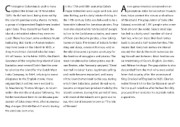Page 480 - The Dutch Caribbean Isles
P. 480
hristopher Columbus is said to have n the 17th and 18th centuries Saba’s non-governmental conservation or-
C sighted the island on 13 November I major industries were sugar and rum, and A ganization, Saba Conservation Founda-
1493. He did not land, being deterred by later fishing, particularly lobster fishing. In tion, helps protect the nature and culture
the island’s perilous rocky shores. In 1632, the 17th century Saba was believed to be a of the island. The population of Saba (the
a group of shipwrecked Englishmen landed favorable hideout for Jamaican pirates. Eng- Sabans) consists of 1,991 people who come
upon Saba. They stated they found the land also deported its “undesirable” people from all over the world. Saba’s small size
island uninhabited when they were res- to live in the Caribbean colonies, and some has led to a fairly small number of island
cued. There has been some evidence found of them also became pirates, a few taking families, who can trace their last names
indicating that Carib or Arawak Indians haven on Saba. The island of Saba is forbid- back to around a half-dozen families. This
may have been on the island In 1635, a ding and steep, a natural fortress, and so means that many last names are shared
stray Frenchman claimed Saba for Louis the island became a private sanctuary for around the island, the most numerous be-
XIII of France. In the latter 1630s, the Dutch the families of smugglers and pirates. The ing Hassell and Johnson. Most families are
Governor of the neighboring island of Saint most notable native Saban pirate was Hi- an intermixing of Dutch, English, Scottish,
Eustatius sent several Dutch families over ram Beakes, who famously quipped, “Dead and African heritage. The population is also
to colonize the island for the Dutch West men tell no tales”. Later, legitimate sailing descended from the Irish who were exiled
India Company. In 1664, refusing to swear and trade became important, and many from that country after the accession of
allegiance to the English crown, these of the island’s men took to the sea, during King Charles I of England in 1625. Charles
original Dutch settlers were evicted to which time Saba lace, pulled thread work, exiled these Irish to the Caribbean in an ef-
St. Maarten by Thomas Morgan, to return became an important product made by the fort to quell rebellion after he had forcibly
within the months and years following. The island’s women. During this period of time, procured their lands for his Scottish noble
Netherlands have been in continuous pos- with most of the island’s men gone out to supporters.
session of Saba since 1816, after numerous sea, the island became known as “The Isle
flag changes (British-Dutch-French) during of Women”.
the previous centuries.

